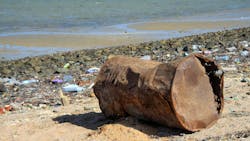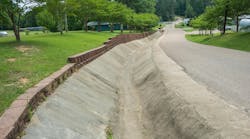EPA data map of sea level rise around hazardous waste sites
The U.S. EPA announced that it has launched a new data visualization map to show the projected sea level rise around hazardous waste facilities within estimated flood zones along the U.S. coastline.
More than 40% of Americans live near the coast. Coastal flooding not only damages roads and homes, but also impacts human health, including by increasing the risk that drinking water, hazardous waste, and wastewater infrastructure will fail, putting people at risk of exposure to pathogens and harmful chemicals.
According to the 2022 Interagency Sea Level Rise Technical Report, global mean sea level could rise between about one and seven feet by 2100. Sea level rise can threaten hazardous waste facilities, like landfills, along the U.S. coastline.
EPA developed this tool to help coastal communities, states, regions, and hazardous waste facility managers to better prepare for the impacts of climate change; independently assess their sea level rise vulnerabilities; and help inform actions they can take to become more resilient to climate change.
The data visualization also references information from the 2022 Interagency Sea Level Rise Technical Report about various scenarios that will affect sea level rise over time. These scenarios depend on several factors, including future greenhouse gas emissions that can impact global warming and the rate of sea level rise.
“This data visualization shines a light on how the climate crisis intersects with and exacerbates significant environmental challenges that disproportionately affect overburdened, under-resourced communities,” said EPA Administrator Michael S. Regan. “Knowledge is power, and this tool will help concentrate our efforts to reduce exposure to toxins, strengthen community resilience, and increase environmental justice.”
According to EPA’s recent Biennial Report hazardous waste data, in 2019, 1.6 million tons of hazardous waste were managed at facilities that would be affected by five or more feet of sea level rise. That includes waste from over 55 facilities. This height range falls in between the intermediate-low to intermediate-high scenarios of sea level rise predictions in the Interagency Report.
Identifying the hazardous waste facilities that could be affected by rising water levels will help both communities and facility managers mitigate potential pollution risks resulting from contaminant release. This action is particularly important for communities that are already experiencing disproportionately high pollution levels, as well as the resulting adverse health and environmental impacts. Communities with residents that are predominantly of color, indigenous, or lower income are also more likely to live near hazardous waste facilities, leaving them disproportionately vulnerable to toxic leaks and contamination caused by inundation.
According to the Sea Level Rise Technical Report, predicted sea level rise will create storm surge heights that increase and reach farther inland. In fact, by 2050, “moderate” (typically damaging) flooding is expected to occur, on average, more than 10 times as often as it does today and can be intensified by local factors.
Specific actions that can be taken by hazardous waste facilities to help prevent releases of hazardous waste from natural disaster damages include:
- Constructing physical barriers (e.g., sand caps, retaining walls), to contain contaminants that are suitable for an identified climate threat (e.g., flooding, intense storms, fires).
- Placing engineering controls (e.g., pumps, electrical equipment) in locations that have a low likelihood of being affected by the identified climate threat.
- Designing containment, monitoring and treatment systems, and subgrade infrastructure to withstand changing conditions from the identified climate threat; and
- Designing landfill or remediation caps (covers over contaminated material) that are resilient to the identified threat, e.g., use drought-resistant plants for vegetated soil caps for long-term erosion control.
The data visualization shares projections up to the year 2100 as well as resources for what communities can do.


